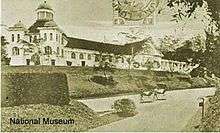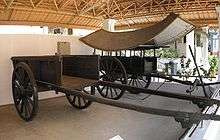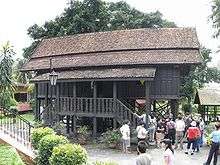National Museum (Malaysia)
Coordinates: 3°8′15.77″N 101°41′13.99″E / 3.1377139°N 101.6872194°E
|
| |
| Established | 1963 |
|---|---|
| Location | Jalan Damansara, Kuala Lumpur, Malaysia |
| Type | |
| Public transit access | Kuala Lumpur Railway Station (KTM Komuter) |
| Website |
www |
The National Museum (Malay: Muzium Negara) is a museum located on Jalan Damansara in Kuala Lumpur, Malaysia. The museum is situated in close proximity to the Perdana Lake Gardens and it provides an overview of Malaysian history and culture. The National Museum is a palatial structure built in the style of Rumah Gadang, an aspect of Minangkabau architecture. Its facade comprises elements of traditional Malay and modern features. National Museum was opened on 31 August 1963,[1] and it serves as a repository of Malaysia’s rich cultural and historical heritage.
The National Museum is a three-story structure of 109.7 meters long and 15.1 meters wide and 37.6 meters at the central point. The museum houses four main galleries allotted to ethnology and natural history. The displays range from free-standing tableaux showing cultural events like weddings, festivals and costumes; to traditional weapons, musical instruments, arts and crafts, ceramics, and flora and fauna.
History

National Museum was established on the site of the former Selangor Museum.[2] It was built by the British and Selangor governments in 1898 following the formation of the Federated Malay States in 1896. On 10 March 1945, during the end of World War II, the right wing of the museum was bombed and destroyed by the US B-29 bomber, from the Allied Forces.[3] The museum's collection was then moved to the Perak Museum in Taiping.
After World War II, the left wing of Selangor Museum was still in use as a historical site. On the brink of the independence of the Federation of Malaya, Prime Minister Tunku Abdul Rahman conceived the idea to build a museum to house national historical and cultural treasures as well as specimens of flora and fauna. The old museum structure was completely demolished to make way for a new museum.
Construction began in 1959 and was complete in 1963. The National Museum was officially opened on 31 August 1963 by Tuanku Syed Putra Ibni al-Marhum Syed Hassan Jamalullal, the 3rd Yang di-Pertuan Agong.[4]
On 4 April 1996 the building was gazetted under the Antiquities Act 169/1976 as an ancient monument and historical site.
Architecture

The museum's design by architect Ho Kok Hoe was inspired by the architecture of the Malay royal palaces and vernacular Malay architecture. The design incorporated the need for exhibition and activity spaces. The large mosaic murals spanning the entrance depict the history and culture of the country. The floor of the central section of the main building is decorated with special tiles which were gifts from the government of Pakistan. In addition, UNESCO facilitated consultancies by museum experts from other museums around the world.
Displays and exhibits in the museum focus on local history, culture and traditions, arts and crafts, economic activities, local flora and fauna, weapons and currency.
The museum houses various galleries, each with its own theme. The ground floor showcases the geographic and natural history of the Malay peninsula starting with the Stone Age, the Bronze Age and the Iron Age, Hindu-Buddhist kingdoms to Muslim sultanate of Malacca. The ancient Malay Hindu-Buddhist states of Gangga Negara, Srivijaya and Majapahit are referenced. Among the collections are the stone makara statue, the bronze Avalokiteshvara of Bidor, the model of Bujang Valley temple in Kedah, and also displaying region's ancient legacy such as Javan Borobudur and Majapahit vessel. The exhibit continues to the later Muslim Sultanate of Malacca and the various states of Malaysia. The display demonstrate the importance of Malaccan sultanate for Malaysian national identity. The second floor is dedicated to the colonial history leading all the way to Independence. There are copies of the royal headgear of Malay rulers.
Central Hall
Adorning the floor of the Central Hall are blue geometric-design mosaic tiles from Pakistan, with intricate carved panels on the ceiling of the hall. The Central Hall houses temporary exhibitions. The matic and special exhibitions are held at this hall at intervals to promote an awareness of the country's diverse culture and heritage. Foreign exhibitions are held occasionally.
Some of the exhibitions that were held in this hall at some point of time included ‘The Islamic Civilization’, ‘Our King’, ‘The World of Flowers’, ‘Durian King of Fruits’, ‘Masks from Sarawak’, ‘World Currency’, ‘Islamic Frontiers of China’, ‘American Frontiers’, and ‘Religious Architecture from the Netherlands‘.
The Museum places strong emphasis on the Malay World, and a considerable section is devoted to the founding of the United Malay National Organisation (UMNO), one of the parties of the National Front (Barisan Nasional). Interestingly, few if at all were any mentions made of the involvement of the Malayan Chinese Association (MCA)and the Malayan Indian Congress (MIC), which 3 parties worked together to achieve Independence of Malaya on 31 August 1957.
Grounds

Other galleries include the National Sports Gallery and the Natural History Gallery.
In the vicinity of the museum building, there are a number of outdoor displays of transportation in Malaysia, past and present. An interesting exhibit is the Melaka Bullock Cart which closely resembles the early American horse-drawn wagon. Of unparalleled interest are the Steam Locomotive made by Kitson & Co, England, which was put into service in 1921 until it ceased operation in 1969. It covered 1.5 million rail miles; a Tin Dredge which resembles a floating factory, on a natural or artificial lake. Also on display are motorised vehicles, including antiqued civic vehicles and private vehicles, including an early 1.3 litre Proton Saga, the first national car launched on July 9th 1985.
National Museum also holds regular thematic exhibitions featuring specific aspects of life and world culture.
Istana Satu

Another attraction of the Museum is an original-size old Terengganu timber palace known as Istana Satu. It was erected by Sultan Zainal Abidin III, Sultan of Terengganu in 1884 in the compound of Kota Istana Maziah, Kuala Terengganu. This building is of Terengganu Malay traditional architecture, in the form called "Rumah Tiang Dua Belas". The wood used is cengal. Istana Satu was erected in the National Museum compound in April 1974.
Rich Malay craftsmanship is evident throughout the palace, from the intricate wood carvings that adorn doors and windows. The restored palace is a charming wooden house designed for the tropics. Standing on stilts that allow air to circulate freely under the building, the palace’s steep thatch roof contributes further to keeping the interior of the house nice and cool.
Standing majestically next to the Istana Satu are two keliriengs or burial poles. A kelirieng is made of a huge hardwood tree trunk, carved from the top to bottom. Niched up to its sides is a space for the bodies of slaves and followers and hollowed at the top to place the jar containing the chief’s bones.
Directors
The founding Director of the National Museum of Malaysia was the late Tuan Hj Mobin Shephard Abdullah. He was in the services of the British government in Malaya and held various posts as the custodian of official records and Keeper of the Rulers Seal. He had an intimate knowledge of the Malay and Muslim Culture.
When Mobin Shephard retired in 1974, he recommended that Shahrum bin Yub be appointed as the second Director General. Shahrum was one of the early "Village Malay" to pursue his studies overseas. He specialised in Malay Culture, History and Anthropology. He joined the Museums Department in the early 1970s and was tutored by Mobin.
Museum Volunteer Malaysia (MVM)
In 2007 cultural and history enthusiasts residing in the greater Kuala Lumpur area formed, with the support of the Department of National Museums, a group of volunteer museum tour guides to accommodate the growing number of international tourists to the museum. At any time, somewhere between 20 and 100 volunteers of many nationalities provide tours in English, Japanese, and French. A related group was established for Malaysian visitors, operating primarily on weekends.
Apart from tour-guide activities, MVM is active in promoting Malaysian cultural and historical heritage in schools and organising tours for members to places around Kuala Lumpur and Malaysia, such as a visit to Kuala Kangsar and Georgetown, Kuala Gandah Elephant Sanctuary,[5][6] Royal Selangor in Setapak and celebrating the Hari Moyang in the Hma' Meri Orang Asli village in Pulau Carey. The group also organised talks and classes for the members and the public to safe-guard as well as introducing the rich cultural and historical heritage of the country.
In 2009, with the collaboration of National Museum, MVM organised the "Jom Main" Exhibition, revisiting traditional games that children in Malaysia used to play.
See also
References
- ↑ "Muzium Negara". Tourism Malaysia. Retrieved 25 May 2014.
- ↑ "Muzium Negara". Tourism Malaysia. Retrieved 25 May 2014.
- ↑ "Muzium Negara". welcome-kl.com. Retrieved 16 July 2012.
- ↑ "Muzium Negara". Kuala Lumpur City Hall. Retrieved 16 July 2012.
- ↑ Kuala Gandah Elephant Sanctuary (Temerloh), Tourism Pahang.
- ↑ Kuala Gandah Elephant Sanctuary, Endemic Guides.
Further reading
- Lenzi, Iola (2004). Museums of Southeast Asia. Singapore: Archipelago Press. p. 200. ISBN 981-4068-96-9.
- Harris, Mark (1990). National Museum, Kuala Lumpur: History and culture of Malaysia. Kuala Lumpur: Syarikat S. Abdul Majeed, Pub. Division. p. 88 pages. ISBN 978-983-9629-15-6.
- Muzium Negara (1988). Gold jewellery and ornaments: In the collection of Muzium Negara, Malaysia. Kuala Lumpur: Persatuan Muzium Malaysia. p. 243 pages. ISBN 978-983-9579-00-0.
- Haji Ali, Mohamed Kassim (1988). Masks of Sarawak in the collection of Muzium Negara Malaysia. Kuala Lumpur: Museums Association of Malaysia. p. 111 pages. ASIN B0006EHZ58.
- bin Mohd. Yatim, Othman (1981). Chinese Islamic wares in the collection of Muzium Negara (Series on the ceramics collection of Muzium Negara). Kuala Lumpur: Muzium Negara. p. 99 pages. ASIN B0006E7THM.
External links
![]() Media related to National Museum (Malaysia) at Wikimedia Commons
Media related to National Museum (Malaysia) at Wikimedia Commons
- Official Site (English) and (Malay)
- Galleries 'A - D' and the outdoor displays of transportation